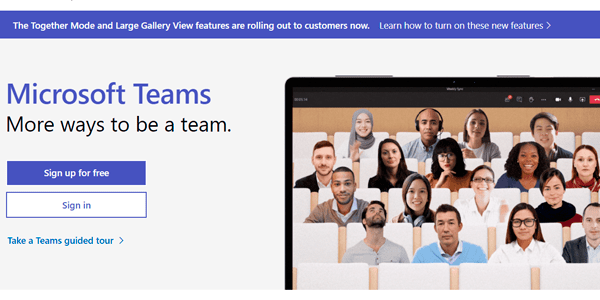Social media is the perfect way to keep your company in the global conversation, but it can be a lot of work. It’s important to find tools that make the whole process easier, and help you reach your goals faster.
Table of Contents
Internal Communications Social Media Tools

Communications professionals are always looking for new and improved ways to boost and enhance their internal communications efforts to ensure they’re reaching employees in the most effective way possible.
Gone are the days where only typewritten memos, phone calls, posters, and staff meetings were the ways management and employees communicated with one another. Connected, digital workplaces now have a range of different company internal communication tools, thanks to advances in technology, where employees can be engaged on various channels.
Why you need the best corporate communication tools
Having the best internal communications tools in your toolkit means your workplace will perform better, have fewer mistakes, be unified, and have higher engagement and morale levels. Every step you take towards improving internal communications is a positive one.
What tools do you currently have in your internal communications toolkit? Here are some of the most popular employee communication tools other companies will be using in 2021… are they right for you?
1. Internal newsletters
Internal newsletters continue to be one of the most popular internal communication tools in the workplace. They allow you to aggregate and collate content and deliver less urgent information at set intervals. It’s a fairly low-cost method of communicating – generally, they are sent via email, which is something all employees have access to anyway. A well-designed, well-written, and eye-catching internal newsletter can help you share important information internally and build a positive team culture.
Pros: Cheap and easy to produce and send.
Cons: Email overload may result in reduced open rates and important information being missed.
Examples of internal communications tools: MailChimp, Campaign Monitor.
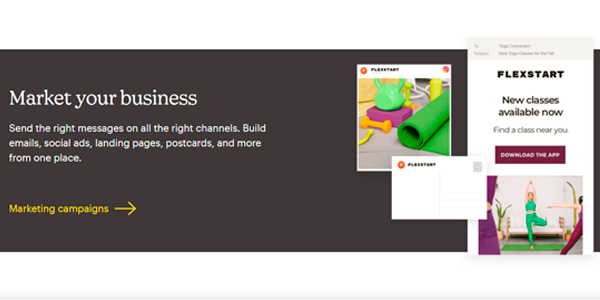
2. Instant messaging
Instant messaging systems let your employees communicate with one another instantly and send text, videos, links, or photos to each other – whether they sit at the next desk or across the world. People are used to communicating on similar systems in their personal lives either via text message, Facebook Messenger, or Whatsapp and often feel comfortable with the more informal and quick communication style of instant messaging.
Instant messengers have been extremely useful employee communication tools as people have had to work remotely during the COVID-19 pandemic. If you have a quick question you need an answer from a colleague, it’s a good way to communicate quickly.
Pros: Instant, quicker than emailing back and forth. Less disruptive.
Cons: Needs everyone to actively use the tool and participate. Not so good for big group discussions, or more formal communication.
Examples of internal communications tools: Skype, Facebook Messenger, Microsoft Teams, Google Chat, Jabber.
3. Intranet
Intranets are one of the most common internal communication tools in the workplace. They are essentially a centralized repository of knowledge, news, documents, and updates that employees can access a broad range of topics.
Pros: A right way to share knowledge and files with restricted access and ensures you have a corporate knowledge base.
Cons: Can become too expansive. Information can be difficult to find. Employees may not even know when there is an important update.
Examples of internal communications tools: Intranet software platforms such as Blink, Slack, eXo Patform.

4. Team collaboration tools
Collaboration software helps to keep your team’s communications in one place. It’s particularly useful for working on projects as well as breaking down “silos” and sharing knowledge with other areas of the organization. They can also be useful in your internal communications toolkit when you have remote workers or project team members based in different geographic locations.
During the pandemic, collaboration software has been used more widely than before, as it has helped teams to remain cohesive while working remotely. This increased uptake is predicted to continue.
Pros: Avoids unnecessary emails. Allows a centralized hub of knowledge. Interactive and encourages a two-way flow of information. Better project management. Increased efficiency and productivity.
Cons: Can be difficult to transition to. Some team members may continue to email and not adopt fully.
Examples of internal communications tools: Microsoft Teams, Slack, Asana, Basecamp, Trello.
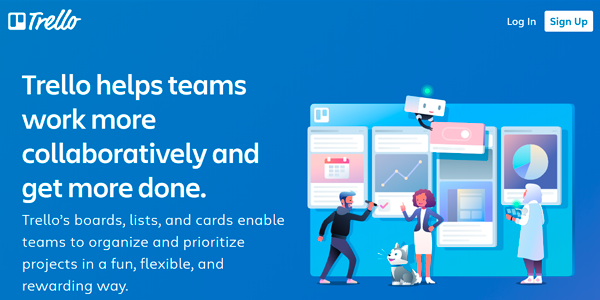
5. Blogs
Internal blogs generally sit on an organization’s intranet site and can become one of the best ways to encourage discussion. There may be a top-down approach to communication in some companies where the blog is written by the CEO and/or senior executives only. In other situations, it might be an opportunity for subject matter experts from across the organization to share information, opinions, and solutions to problems in a conversational way.
Pros: Useful for sharing information, important announcements, reinforcing policies and procedures and addressing frequently asked questions. Promotes discussions and meaningful conversations.
Cons: Should be regularly updated to be one of the more meaningful communication tools in the workplace. May not be easy to locate on the intranet. May not be read widely.
Examples of internal communications tools: Blogging platforms such as WordPress, Joomla, Drupal.

6. Corporate social media
Employees are used to using social media in their personal lives to share information with friends, and using it for work purposes is a logical step for many. There are some purpose-built platforms that you can only use within a company (such as Yammer) and other times companies may use established social networks like Facebook. As part of the internal communications toolkit, these are ways to quickly and informally share information and collaborate.
Pros: Information can be shared quickly. Social media integration can be free or cheap.
Cons: Even in this day and age, not everyone has social media. Some employees would be reluctant to link personal social media accounts to their company and wouldn’t view these platforms as internal communication tools and it wouldn’t be their first port of call to find out information. Allowing social media use at work could be misused. You don’t own the platform and terms and conditions can change constantly.
Examples of internal communications tools: Workplace by Facebook, Yammer.
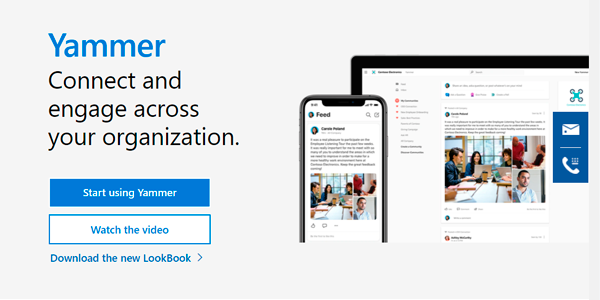
7. Video chat
Video is particularly useful for internal communications in large companies, or companies spread across different geographic locations. It is one of the best ways that enables co-workers in different offices to talk face-to-face even though they may be many miles apart – or even on the other side of the world from one another.
While traditionally they could do this by telephone or traveling to one location for a meeting, video chat software enables everyone to get together without leaving their usual place of work. During the COVID-19 pandemic, video chat software has enabled colleagues to continue to have face-to-face one-on-one conversations while working remotely or meet as a group face-to-face when social distancing and other restrictions make in-person meetings impossible.
Pros: Saves on travel costs. Saves on travel time meaning people can be more productive. Builds a more collaborative team environment. Is more flexible than traditional meetings.
Cons: Technological issues can sometimes make it hard to use, such as slow internet connections or poor facilities and equipment.
Examples of internal communication tools: Skype, Zoom, Microsoft Teams, FaceTime, PowWowNow.
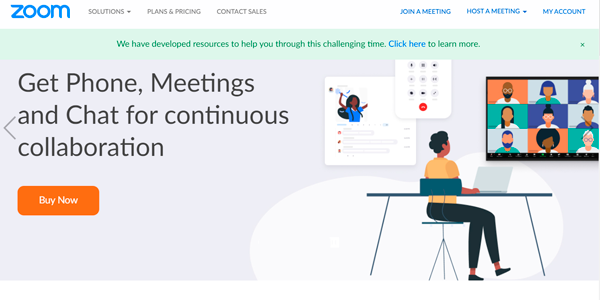
8. Video broadcasts
When you have an important official announcement to make, your CEO or other executives can’t be in every office of a large company at once. Your corporate office may have regular staff meetings that people in regional outposts miss out on and can’t attend. A good way to keep employees in the loop is to broadcast these types of events so that everyone can see and hear, regardless of where they are. Tools such as GoToWebinar can help, and for those who miss out because they were off sick, traveling, on vacation, etc. the recording can still be accessed later.
Pros: Relatively cheap and easy to implement provided you have best quality camera and sound equipment. Time zone issues can be overcome by recording broadcasts and making them available later.
Cons: These business communication tools may not solve issues when there are language barriers. Some mobile staff may lack the bandwidth on internet plans to watch lengthy video broadcasts regularly.
Examples of internal communications tools: GoToWebinar, Zoom, Webex

9. Alerting software for important communications
DeskAlerts is an internal communication software system with many features that can instantly deliver critical messages to employees’ computers, smartphones, or tablet devices using various channels, grabbing users’ attention quickly. Pop-up messages on screens and push notifications on mobile devices form the backbone of this product, but other features include scrolling tickers, surveys, polls, quizzes, corporate screensavers, corporate wallpaper, digital signage, and more to give you different options and allow you to run a best practice and comprehensive internal communications campaign.
Pros: One of the most versatile communication tools in the workplace. Very good if you’re on a budget and don’t want to buy multiple software packages! Bypasses email system and cuts through all the other digital noise and clutter in employees’ daily work lives.
Cons: If you have a unique workplace with no computers, phones or tablets you won’t be able to use it.
Example of internal communications tools: DeskAlerts

10. Team bonding tools
Tools that help your team get to know one another better can break down silos and foster greater collaboration and knowledge sharing. An example is Donut – an integration that people use with Slack – that randomly pairs two people from across an organization and schedules an informal chat so they can get to know one another. Whether it’s bringing together two co-workers who are in the same building, or two who are in different countries, it is a good way for people to get to know what other parts of the company do and understand other perspectives.
Pros: Fosters sharing. Builds a team culture. Creates higher levels of engagement.
Cons: Many introverts will hate it and won’t opt-in unless forced. If your workplace is predominantly introverted, it may not be a good tool.
Examples of internal communications tools: Donut, Slack, Microsoft Teams
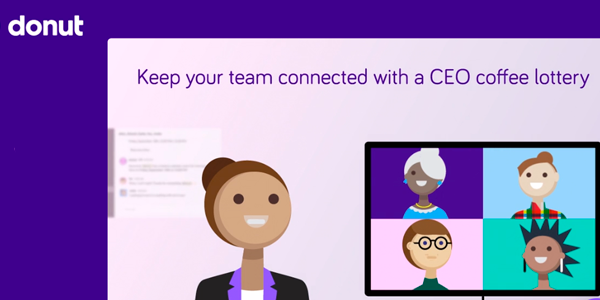
11. Surveys
Internal communication isn’t all one-way. For it to be successful, there should be some tools in your internal communications toolkit intended for two-way communication between management and employees. And a perfect way to do this is via surveys. Surveys can help you determine employees’ perspectives on many aspects of your company. You can then take steps to change things, and then survey again at a later date to have data to show whether your measures were successful or not.
Pros: Easy to implement – particularly if you have an all-in-one communications tool like DeskAlerts. Survey software does the math calculations for you, taking a lot of the hard work out of it compared to paper-based surveys. Anonymous nature of surveys can give you better feedback from employees who may be reluctant to share their views otherwise.
Cons: If questions are not specific, you will not get meaningful answers. If employees feel you don’t listen to what they tell you in surveys they may be reluctant to fill in future surveys.
Examples of internal communications tools: DeskAlerts, Survey Monkey

12. Forums
Discussion forums have been part of the internet for a long time. Before the rise of social media, they were one of the most popular ways people would communicate on just about any topic. Discussion “threads” allow multiple people to ask questions, share opinions, get feedback, and solve problems. While many internet forums died off when social media took over, some sites such as Reddit are still very popular, proving that people still like having the ability to share and discuss things this way. The forum software can be added to your company intranet to give employees a place to discuss issues.
Pros: Most intranet software will have a way to integrate this easily. Lets employees be more collaborative and solve problems together without going outside the company for help with internal issues.
Cons: May need to be moderated, meaning it will take more resources.
Examples of internal communications tools: Forum platforms such as vBulletin, Zendesk.
13. Podcasts
Podcasts are enjoying a lot of success right now, with many people tuning in to them for personal enjoyment or professional development. People are used to listening to them while they work, commuting, or even in their downtime while relaxing. Podcasts are better than video because you can listen while driving, for example. This is a good way for internal communicators to tap into preferences and create content on any topic that you want your employees to know about. From corporate announcements through to training, the subject matter of the content you create is practically limitless.
Pros: Relatively easy to produce and distribute. Overcomes issues associated with a video.
Cons: Not everyone will want to listen to podcasts. Best used in conjunction with other internal communication methods.
Examples of internal communications tools: Podcast software such as Logic Pro, Audacity, Adobe Audition, Alitu.

14. Screensavers
Many computers these days no longer use screensavers- they were originally invented as a way of preventing older styles of monitors from having a particular image burned into it if it stayed static for too long. Modern monitors are LCD and don’t have this problem, but screensavers are still an option that can be turned on in operating systems if a computer has been idle or unattended for too long. Capitalizing on this feature is a good way to turn your employees’ screens into mini digital billboards. You can communicate just about anything, from new product launch details to reinforcing your corporate values… or just using them as part of your overall branding, displaying the company logo.
Pros: Very easy to implement in major operating systems. A good passive way to reinforce your communications campaigns.
Cons: In most cases, you can’t send custom screens to different users simultaneously and need to attract IT staff every time you need to send something unless you have a tool like DeskAlerts.
Examples of internal communication tools: DeskAlerts screensaver tool, Adobe Spark.

15. Digital signage
When you have other screens throughout your company, such as TV screens in waiting rooms or staff kitchens, they are valuable real estate where you could be communicating company news, remind people about upcoming events, reinforce other messaging such as security and privacy reminders, or showcase your values to a captive audience.
Pros: Easy to use. Capitalizes on screens that may otherwise not be used at all, or only rarely.
Cons: Can be seen by visitors to the company so not useful for secure or sensitive information. Not good for long-form communication on complex subjects.
Example of internal communications tools: DeskAlerts digital signage.

16. Planning tools
Planning tools are a good way to help you get organized and map out your internal communications in advance so you aren’t always rushing around at the last minute looking to fill content holes.
These tools, such as an internal communications editorial calendar, can help you keep track of deadlines, organize and prioritize your workflow, and streamline workflow distribution.
You can even share your planning tools with other parts of the organization so everyone is on the same page – that way they can get information to you and approve content while understanding your needs.
Pros: Increases organization, saves time, helps with teamwork and accountability.
Cons: If other teams in the organization ignore it and don’t stick to deadlines.
Examples of internal communications tools: Excel, Google Drive, Trello.
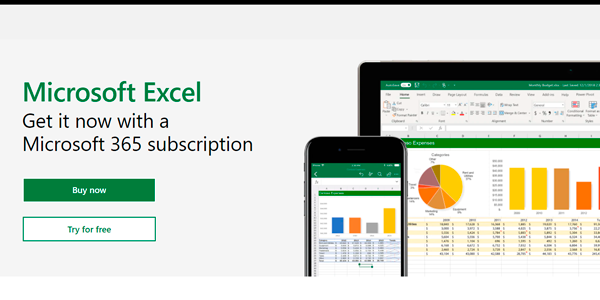
17. Employee experience tools
Employee experience tools are customized software applications that help to embed aspects of your company culture. They form part of the overall experience that employees have working for your organization.
These tools will let your employees easily access the information they need to do their jobs, such as their planners and emails, documents they’ve been working on and their most used software applications.
They can also be used to help coordinate training, ensure a consistent onboarding experience and deliver information that employees need such as payroll information, leave entitlements and balances, managing holidays and accessing employee benefits.
Pros: Assists organizations maximize productivity in the workplace, reduce wasted time, and improve employees’ working environment.
Cons: May contribute to information overload if not managed appropriately. Older employees may not be comfortable with using them.
Examples of internal communications tools: Officevibe, Qualtrics, Kudos.

18. Virtual events
Virtual events go further than the average webinar or live stream – they’ve evolved during the COVID-19 pandemic and the subsequent new era of remote/hybrid working that has become the “new normal” in the last year.
Virtual events are mass-employee company events that take place online, and in addition to streaming vision and audio, they allow employee engagement and interaction via the ability to ask questions, respond to live polls and even allow the organizers to determine which employees are paying attention and which ones are inattentive. They provide rich analytics instantly.
They’re a great alternative to town-halls and roadshows in large organizations and ensure everyone can find out the same information at the same time as much as is practicable (employees who aren’t on duty may have to watch a recording, but as many town halls aren’t recorded this is still an improvement).
Pros: Less resource-intensive and cheaper to run than taking townhalls on the road in big organizations. Improves information equality and can reduce resentments when regional offices feel they are neglected and forgotten.
Cons: Some employees have poor internet access and the live event experience could be suboptimal. Others may be getting fatigued by too much screen time.
Examples of internal communications tools: GoToWebinar, StreamGo
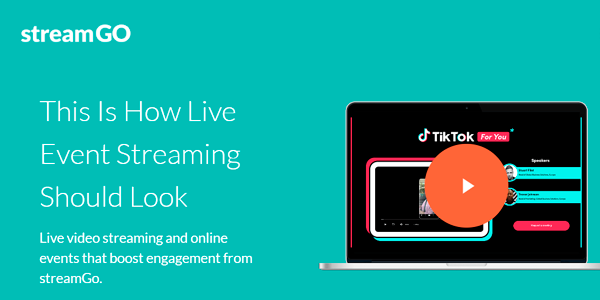
19. Idea management tools
These software applications help make it easier for organizations to gather ideas and feedback from employees to help improve or create new products or systems.
Not only does this help to encourage innovation and drive more successful outcomes in terms of productivity and client relations, but it can help with employee engagement as well. A Salesforce survey found that employees who feel as though their voice has been heard by management are around four to six times more likely to perform at their best.
Pros: Drives innovation and can help to solve just about any problem in the organization, whether its safety, communication issues, making processes more efficient, or responding to common customer issues.
Cons: If your workplace is toxic and you have a leadership team that is known to be punitive you may find employees are reluctant to share ideas.
Examples of internal communications tools: Ideanote, Qmarkets, Brightidea.
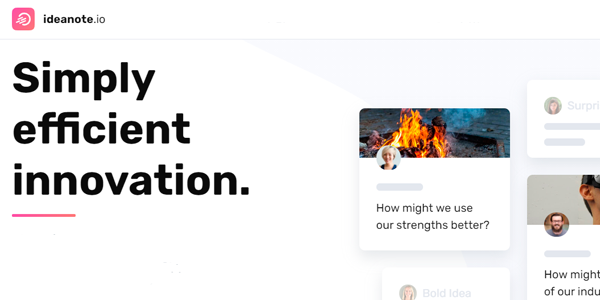
20. Employee engagement software
This software can help to round out your employee engagement efforts and gauge the mood of employees. You can use it in conjunction with other employee engagement tools such as surveys and wellbeing programs.
They are especially useful for managers with remote teams so they can determine how engaged their direct reports are.
Pros: Helps to boost productivity and collaboration, improves transparency and accountability, can help you retain top employees.
Cons: The software is only as good as your managers. If they’re not committed to acting on results and generating change and improvements, employees will rightly be cynical.
Examples of internal communications tools: 15Five, Qualtrics, Hive.

21. Employee apps
This is another tool that has really come into its own during the COVID-19 pandemic. An app is a great way to communicate with a remote workforce or non-office workers. When information changes quickly, such as forced closures, rostering, stock levels, safety advice, etc. you know you can quickly and easily reach employees by sending notifications to their smartphones or tablets.
Pros: Can easily reach all employees at once, or send to custom audiences or even individual staff members. Is highly visible.
Cons: There are actually still some people out there who don’t have mobile phones. Also isn’t reliable if someone has their phone switched off, in airplane mode, or has a poor internet connection.
Example of internal communications tools: DeskAlerts mobile app.

22. Employee recognition apps
These tools are a great addition to your internal communications toolkit. Employee recognition apps let employers recognize and reward their employees for their performance and achievements.
These tools are used to track employee performance as well as provide feedback, identify training needs, encouraging teamwork and collaboration and getting team members to celebrate one another’s’ successes.
Pros: Makes your reward and recognition programs highly visible, easy to access and sharing in a fun way.
Cons: Some age demographics might not like using them.
Example of internal communications tools: Fond, Bonusly, Awardco, Kudos
employee communication platforms
Here’s a brief description of each employee communication software to showcase each tool’s best use case, some noteworthy features, and screenshots to give a snapshot of the interface.

- Start your 30 days free trial now, with no feature restrictions and zero commitments
- https://www.empuls.io/pricing
Empuls – Best for centralized internal communications

Empuls lets you centralize internal communications with a social intranet.Empuls is an employee engagement solution that aims to improve company culture and bring the entire digital workplace to life. People leaders use Empuls to build a culture of appreciation, bring teams together, eliminate silos, and provide a voice to every employee. Empuls comes with features such as one-on-one feedback, peer & social recognition, and a wide variety of benefits like rewards & perks. With Empuls, your HR team can focus on strategizing rewards and recognitions and not get bogged down with operational complexities. Empuls also lets you centralize internal communications with a social intranet platform and motivate employees with a reward of their choice when they deliver good performance and exceed expectations. You can also run reward programs that power business results, align employee recognition programs with company culture and values and make recognition frictionless, candid, social, and fun. You can also measure the impact of your employee engagement initiatives and employee sentiment with real-time feedback. Empuls integrates with HRIS / HRMS / HCM, and single sign-on tools. Empuls costs from $2/user/month and offers a 30-day free trial.

- freemium version
- 14 days free trial
- From $8/user/month
monday.com – Best for employee communication around tasks & projects

monday.com offers both passive and active communication channels whereby you can either glean necessary information from dashboards and reports or send messages, comment, tag people, and build surveys.
monday.com is marketing mainly as a workflow tool for scaling an organization, but they’ve also built in several HR features. They are not a pure HR software but it’s a useful tool with a lot of the basics, particularly when it comes to internal communications and collaboration (in which they very much excel).
monday.com can be your day-to-day workflow management tool for deadlines, HR workflows, and resource tracking with built-in communication features like commenting, approvals, @-tagging, notifications & alerts, customizable dashboards, a built-in inbox, social media-esc “likes,” and email integration.
For the best employee communication functionality, take advantage of their “docs” system, where you can build collaborative or read-only company manuals, checklists, or wikis. You can also build “request forms” so that your employees have an easy way to report issues or new ideas right in the platform.
monday.com’s integrations include project management apps like Slack, Google Workspace, Gmail, Jira, GitHub, Trello, Dropbox, Typeform and many more, accessible through a paid plan with Zapier.
monday.com costs from $8/user/month and offers a free trial.

- From $6/user/month
Gmail + Hangouts – Best for those already in the Google ecosystem

Google offers email, chat, and video conferencing integrated into their free employee communication software.
Google has built a suite of communication and collaboration tools around its wildly popular Gmail solution for email. Thanks to continuing investment and innovation, these apps have become the de facto choice for millions of organizations worldwide. Built for the cloud and backed by Google’s immense resources, these tools have proved their worth in a competitive environment.
Google apps are perfect for startups who need a free employee communication software option. Almost everyone has a Google account and knows how to use basic functions such as Gmail. But the paid Google Workspace solution can scale with their business, even up to enterprise level.
This solution scores very highly in terms of integration possibilities, as almost every workforce app is designed to work with Google.
Google Workspace costs from $6/user/month. Basic Gmail/Hangouts accounts are free for up to 15GB of storage.

- From $88/user/month
Staffbase – Best for a mobile-first intranet

Staffbase keeps all your employees up-to-date with company news and events, from the back office to frontline workers.
Staffbase aims to solve employee communications challenges by uniting diverse teams in multiple locations. This end-to-end internal communications platform helps with distributing important content to employees across an entire organization.
Using the Staffbase Experience Studio, editors can plan, create and publish content, then measure its impact. Distributed editors can add local content with no tech skills required.
Staffbase is a mobile-first solution designed to optimize effective internal communication within larger distributed organizations. The employee mobile app integrates with company intranet software to facilitate company-wide communications. As a result, frontline team members get the fast response they need, while management gets detailed insights and reporting.
Staffbase integrates with Microsoft 365, major HR applications, and other SaaS software.
The software costs from $88/user/month and a free demo option is offered.

- From $1/user/month
HubEngage – Best for engagement and deep insights

HubEngage connects employees company-wide with features focused on engagement.
HubEngage set out to offer a better working experience to employees. The software is designed to distribute content such as news, videos and documents to employees, while also allowing team members to submit ideas and stories for consideration. HubEngage is used by organizations ranging from small hospitals to large global manufacturers.
Features such as gamification help maximize employee interaction and engagement while also providing incentives to perform well. Team members can engage with likes, comments, and sharing while earning points and rewards. The software encourages both top-down distribution of company news feeds and other information, plus bottom-up feedback from employees.
The software integrates with SSO, Microsoft Teams, SharePoint, Workday, ADP, Ultipro, and similar software.
HubEngage costs from $1/user/month. There is no free trial option.

- From $28.80/user/month
Appspace – Best for a simple workplace engagement and productivity tool

With Appspace, you can easily see who is actively contributing to your success.
Appspace offers employee communications tools designed to connect all your employees, no matter where or when they work. The software aims to cut through the noise of emails, chat, and oversaturated communications channels to highlight critical information employees need to know. Updates can be scheduled and shared anywhere, with options to communicate critical and emergency messages immediately.
Appspace can be used to send messages over popular communications channels to reach everyone in the organization effectively. Managers can measure and analyze engagement and keep track of how published information is performing. These insights can then be used to drive a better communications strategy and enhance retention.
The software integrates easily with Slack, Webex, Microsoft Teams, and other communications platforms.
Appspace costs from $28.80/user/month. A free trial plan for up to 2 users is available.

- freemium version
- Pricing upon request
PeopleONE – Best for comprehensive corporate communications

PeopleONE keeps your workforce up-to-date with news, events, and key information.
PeopleONE is a digital workspace software solution that aims to improve internal communications. It comes with pre-defined features for HR, IT, facilities and business teams, helping to deliver tailored news, holiday calendars, wellness information, events and leadership communications.The software ensures clear ownership of content creation, permissions, and approval mechanisms.
This solution is a solid choice for corporate communications.Using Microsoft Office 365’s SharePoint, PeopleOne enables the distribution of corporate news, events, and announcements, while the document management system provides access to processes, policies, and procedures. Leaders can also connect with employees to share information, thoughts, and insights.
PeopleONE has pre-built integrations with major email and messaging platforms, Office 365, and social media networks.
PeopleONE offers customized pricing upon request. There is no free trial option.

- From $500/month for an unlimited number of users
Cerkl Broadcast – Best for time-sensitive communications

Cerkl allows you to prioritize critical news items for increased distribution and exposure.
Cerkl helps organizations streamline the channels they use to communicate and engage with audiences. Features include content management, dedicated email, and business insights. The power of artificial intelligence is used to ensure the right message is delivered to the right person at the right time.
Managers can distribute internal content using email, messaging, or mobile apps. A centralized dashboard gives real-time data which can be used to optimize communications. Businesses around the world are using Cerkl to inform management and ignite the potential of their workforce.
The software integrates with SSO, Slack, Teams, Sharepoint, and other popular software platforms.
Cerkl costs from $500/month for an unlimited number of users. A free demo plan is available.

- Pricing upon request
Happeo – Best channel-based communication

Happeo uses channels to sort communication by theme: company news, onboarding welcomes, drafts & approvals—all with widget enhancement options.
Happeo is a social intranet that aims to make employee communications more dynamic and collaborative. The software is designed for businesses that use Google Workspace. Combining a social network with a team collaboration platform, Happeo improves employee engagement, two-way communications, and workflows.
All employee communication happens in Channels, the digital workplaces where team members meet, socialize, and collaborate. Channels offer a secure, social environment where communicators can post messages, share initiatives, and like posts.
Happeo integrations include Google Workspace, Trello, Slack, and Salesforce.
Happeo offers customized pricing upon request. There is no free trial.

- 30 days free trial
- From $3.33/user/month
SnapComms – Best for a branded employee app

Reach employees using multiple devices and platforms through a single, branded app.
SnapComms is a critical event management and employee communication solution. The software uses visual displays in prominent locations to bypass email, so that key information can be delivered to update teams in the workplace.
All of this is delivered using a branded app that works on any device. You can keep remote employees in the loop and connect them to the broader organization. Employees can receive messages on mobile, tablet, or desktop devices.
Software integrations include Slack and Google Workspace.
SnapComms pricing starts from $3.33/user/month. A 30-day free trial is available
Conclusion
Let us know your thoughts in the comment section below.
Check out other publications to gain access to more digital resources if you are just starting out with Flux Resource.
Also contact us today to optimize your business(s)/Brand(s) for Search Engines

